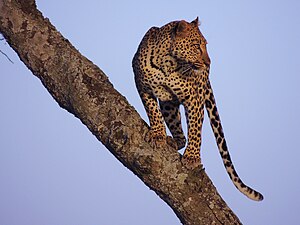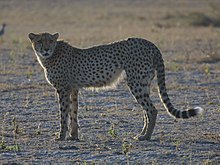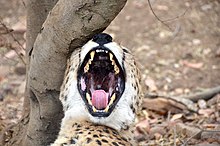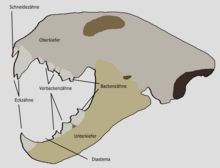Cats
| Cats | ||||||||||||
|---|---|---|---|---|---|---|---|---|---|---|---|---|

Leopard ( panthera pardus ) |
||||||||||||
| Systematics | ||||||||||||
|
||||||||||||
| Scientific name | ||||||||||||
| Felidae | ||||||||||||
| Fischer , 1817 |
The cats (Felidae) are a family from the order of the carnivores (Carnivora) within the superfamily of the feline (Feloidea). They are widespread on all continents except Oceania and Antarctica and are almost exclusively carnivores. They are divided into large cats (such as lions , tigers and leopards ) and small cats (such as wild cats , lynxes and ocelots ), with small cats also including large representatives such as the puma and - according to recent molecular genetic findings - the cheetah . With the house cat , which is descended from the African falcon , a representative of the family became a companion of humans through domestication .
features

anatomy
In appearance and behavior , most cat species widespread resemble domestic cat . They have sleek bodies, soft fur, short faces, and relatively small skulls. The cheetah deviates most from this with its dog-like body. All cats have a tail that helps them keep their balance and is also needed for intra-species communication . In some types of cats such as B. the lynx , however, the tail is greatly shortened. In contrast to the relatively uniform physique, the size spectrum of the cat species varies considerably. It ranges from about 30 cm head-trunk length in the black-footed cat of South Africa to over 200 cm in species of the genus Panthera .
eyes
The cats' eyes are relatively large in relation to the skull. The size of the opening of the pupils of the cat's eyes can be greatly changed; in bright ambient light the pupils in small cats are vertically slit-shaped, in other types of cats they are small and round, and in the dark the pupils are extremely wide open. Some cats have multifocal lenses that allow greater visual acuity. Domestic cats have such lenses (and the corresponding slit-shaped pupils). Other cats, such as Siberian tigers , have "common" monofocal lenses.
Cats have a reflective layer of tapetum lucidum behind the retina in the eye, which reflects back those light components that have penetrated the retina so that they hit the retina a second time. In addition to an improved twilight vision, this layer also causes the incident light to be reflected on the eyes in the dark (compare also cat's eye as a colloquial term for reflectors). The rod / cone ratio of the retinal receptors is about 63 to 1 (in humans the ratio is 20 to 1), but varies greatly between the center of the retina (10 to 1) and the periphery (200 to 1). Cats can therefore see very well even when there is little ambient light (twilight, night). Cats can only perceive colors to a limited extent, but they are not completely color-blind . Since the cat can hardly move its eyes to the left or right, it has to move its head in order to see in another direction. The forward-facing eyes result in a strong overlap of the visual axes, which means better spatial vision. The cat's viewing angle is 200 to 220 °.
Ears
The cats' ears are upright, pointed to rounded and can be turned in different directions. You have excellent hearing . The frequency range goes up to around 65,000 Hz, which is more than three times that of humans. A cat's ears can be rotated independently of one another over a large angular range, which makes it possible for them to acoustically localize prey and to catch them with a targeted jump even in the dark. The auricles are covered with hairs to prevent foreign objects from entering.
The cat's mood can also be read in the ears: wide ears indicate a willingness to defend; Standing upright and curiously facing forward means that she is interested in her surroundings and observes them more closely.
Tongue and sense of taste
Taste recognition is necessary in order to identify spoiled or inedible food, and it must be carried out precisely and quickly in cats because they do not chew their food. The tongue is rough because it is covered with papillae . The central papillae are covered with thorns that point towards the body. These thorns are used to comb the skin or to scrape the meat off bones. The anterior papillae are used for the actual taste perception. This mainly applies to sour, salty, bitter and umami . Cats cannot taste sweet: the animals lack parts of the gene that carries the information for half of the recognition protein for “sweet”. The result is an inoperable receptor in the taste buds of the cat's tongue.
Sense of smell
Cats rarely follow a trail with a smell. Their sense of smell is less developed than, for example, dogs or bears .
Whiskers

The whiskers (zool. Vibrissae ) characterize the cat as a predominantly nocturnal animal. Cats have whiskers especially on the snout, but also over the eyes and on the lower forelegs. The vibrissae are set into vibrations by air movements, which are converted into a spatial image of the environment via sensory cells on the whisker hair roots - cats thus at least "see" rough spatial structures of their immediate surroundings even in complete darkness. The vibrissae are already fully developed in newborns, which shows the importance of the sense of touch.
denture

The upper and lower jaw are connected by a hinge joint. The set of teeth usually has 30 teeth ( tooth formula : upper jaw : 3-1-3-1; lower jaw : 3-1-2-1); The species of the lynx genus have only two premolar teeth in the upper jaw and thus 28 teeth (upper jaw: 3-1-2-1; lower jaw: 3-1-2-1; however, individual lynxes can have an additional molar tooth on one or both sides in the lower jaw exhibit). A diastema (a gap in the row of teeth) allows the canines (canini) to slide past each other when the mouth is closed. The long, dagger-like canines or fangs are used to grab, hold on and kill the prey, the fangs are used to bite off pieces of meat that are swallowed without further chopping. The tear teeth are enlarged by the last Vorbackenzahn ( premolar ) and the first molar tooth ( Molar formed). They have jagged tips that slide past each other like scissors when biting.
Claws
Cats are toe and crusaders and have five toes on their front paws and four on their hind paws. The claws of the front paws are also stronger than those of the hind paws. With the exception of the cheetah , the flat-headed cat and the fish cat - these can only partially retract their claws - all cats have "extendable" sickle-shaped claws made of horn. These claws are only extended by tensing certain muscles during use (fighting, catching prey, climbing). So that they do not wear out while running, but stay sharp, they remain in the skin sheaths when not in use. The involuntary extension of the claws is prevented by tendons inside the toes.
With their sharp claws, cats can climb trees very well, but to descend the cat must have learned to use their claws, which are curved forwards, as "climbing hooks". Inexperienced cats try to climb down head first, which can quickly get them into trouble, panic, and paralysis.
The softly padded toes and retractable claws make it easy for cats to sneak up on their prey. The sense of touch on the paws is very strong, one reason why cats also examine objects with their paws.
distribution
Cats are common on all continents with the exception of Antarctica. In Australia and Oceania, however, they were only introduced by settlers. There are no cats north of the 70th parallel .
Social behavior
Most cat species are solitary animals. Male and female animals only come together to mate and then separate again. Exceptions are in particular the lions , who live in larger packs, and smaller groups of male cheetahs living together .
nutrition
Unlike many other predators , which are more or less omnivorous , cats eat almost exclusively meat. They are highly specialized predators that stalk their prey ( hide hunters ) or sneak up close to them in order to overwhelm them after a few sets or a short sprint. This last-named hunting method has been particularly developed for cheetahs that are set up to reach very high speeds (over 100 km / h). This allows them to track their targeted prey over a distance of a few hundred meters. In contrast , the comparison of this hunting method with the hunted hunt for pack- hunting canids and spotted hyenas is inaccurate : In contrast to hunters, cheetahs cannot exhaust their prey by perseverance (which is the principle of the hunt), but have to do it within a short time (hardly more than a minute) catch up with their higher speed.
In the wild, most cats prefer live-caught prey and only occasionally eat carrion .
Systematics of cats


A distinction is made between about 40 types of cats, all of which are relatively similar in physique and outwardly vary in color and size. Only the cheetah differs more clearly from other cats in this regard. The uniform physique made it difficult to subdivide the family on the basis of morphological criteria.
Traditional systematics
Traditionally, three living subfamilies, the big cats , the small cats and the cheetahs were distinguished. The cheetah stood apart as a separate subfamily cheetahs (Acinonychinae); the genera Panthera (lion, jaguar, leopard, tiger and snow leopard) and the clouded leopard formed the big cats (Pantherinae), while the other species were grouped together as small cats (Felinae). Another subfamily that is now extinct are the saber-toothed cats . This system was based on Collier and O'Brien ( A molecular phylogeny of the Felidae: immunological distance , 1985) and was the most common for a long time. An important distinguishing criterion of this subdivision was on the one hand the morphology of the claws, which are not retractable in cheetahs, and on the other hand the structure of the hyoid bone, which is elastic in large cats and ossified in small cats. The ability to roar or purr was attributed to this difference. Some big cats (lion, tiger, leopard, jaguar) can roar in contrast to the small cats. All cats can purr , but big cats can only purr when they exhale, and small cats both when they inhale and when they exhale. In the meantime it has been found that the ability to roar does not depend on the hyoid bone, but is related to the structure of the larynx.
Modern systematics
With the development of molecular genetic methods with the help of which DNA sequences can be compared, it was recognized that the traditional trisection of cats does not reflect the actual relationships. There is no doubt about the monophyly (all subgroups come from one parent form) in cats. The following genera and species are counted as cats:
So it turned out that the cheetahs do not form a subfamily of their own, but are closely related to the pumas and thus belong to the small cats. According to the analyzes, the recent cat species are divided into eight main lines, which probably split off from the main branch in the order listed here. The first split, that of the big cats, probably took place around 10.8 million years ago, while the most recent, the split into the domestic cat line and the Bengal cat line, probably took place around 6.2 million years ago.
| Cats |
|
||||||||||||
|
|
| Big cats |
|
||||||||||||||||||||||||||||||||||||
|
|
| Small cats |
|
||||||||||||||||||||||||||||||||||||||||||||||||||||||||||||
|
|
Relationships of cats according to O'Brien & Johnson (2008), of big cats according to Johnson et al. (2006), Nyakatura and Bininda-Emonds (2012) and Tseng et al. (2013).
-
Big cats (Pantherinae) (10.8 million years)
- Genus Neofelis
- Clouded leopard ( Neofelis nebulosa )
- Sunda Clouded Leopard ( Neofelis diardi )
- Genus pantherlike ( Panthera )
- Lion ( panthera leo )
- Jaguar ( Panthera onca )
- Leopard ( panthera pardus )
- Tiger ( panthera tigris )
- Snow leopard ( Panthera uncia )
- Genus Neofelis
- Asiatic golden cats and marble cats (9.4 million years old)
- Genus Asian golden cats ( Catopuma )
- Borneo golden cat ( Catopuma badia )
- Asiatic golden cat ( Catopuma temmincki )
- Genus Pardofelis
- Marble cat ( Pardofelis marmorata )
- Genus Asian golden cats ( Catopuma )
- Caracal group (8.5 million years)
- Genus Caracal
- Caracal ( Caracal caracal )
- African golden cat ( Caracal aurata )
- Genus Leptailurus
- Serval ( Leptailurus serval )
- Genus Caracal
- Ocelot line (8 million years)
- Genus Pardelkatzen ( Leopardus )
- Pantanal Pampas Cat ( Leopardus braccatus )
- Colocolo ( Leopardus colocolo )
- Eastern ocelot cat ( Leopardus emiliae )
- Garlepp's Pampas Cat ( Leopardus garleppi )
- Spotted cat ( Leopardus geoffroyi )
- Chilean Forest Cat ( Leopardus guigna )
- Southern tiger cat ( Leopardus guttulus )
- Andean cat ( Leopardus jacobitus )
- Muñoa pampas cat ( Leopardus munoai )
- Southern Pampas Cat ( Leopardus pajeros )
- Ocelot ( Leopardus pardalis )
- Northern tiger cat ( Leopardus tigrinus )
- Long-tailed cat ( Leopardus wiedii )
- Genus Pardelkatzen ( Leopardus )
- Lynx group (7.2 million years)
- Genus lynx ( Lynx )
- Canadian lynx ( Lynx canadensis )
- Eurasian lynx ( Lynx lynx )
- Iberian Lynx ( Lynx pardinus )
- Bobcat ( Lynx rufus )
- Genus lynx ( Lynx )
- Puma Group (6.7 million years)
- Genus Acinonyx
- Cheetah ( Acinonyx jubatus )
- Genus Pumas ( Puma )
- Puma ( Puma concolor )
- Jaguarundi ( Puma yaguarondi )
- Genus Acinonyx
- Bengal cat group (6.2 million years)
- Genus Otocolobus
- Manul ( Otocolobus manul )
- Genus old cats ( Prionailurus )
- Bengal cat ( Prionailurus bengalensis )
- Sunda Cat ( Prionailurus javanensis )
- Flat head cat ( Prionailurus planiceps )
- Rust cat ( Prionailurus rubiginosus )
- Fish cat ( Prionailurus viverrinus )
- Genus Otocolobus
- Domestic cats line
- Genus Real Cats ( Felis )
- Gray cat ( Felis habeni )
- Pipe cat ( Felis chaus )
- Felis lybica , including the house cat
- Sand cat ( Felis margarita )
- Black-footed cat ( Felis nigripes )
- European wildcat ( Felis silvestris )
- Genus Real Cats ( Felis )
It is relatively uncertain whether the mountain cat belongs to the ocelot line.
evolution
According to current opinion, the cats are descended from the ancestors of the stealthy cats or related forms from the group of feline predators. Even before the appearance of the actual cats existed the Nimravids or pseudo-saber-toothed cats, which are very reminiscent of cats, but are now placed in their own family (Nimravidae). They are considered the sister group of the Felidae and not their ancestors. The oldest fossil finds of cats are around 30 million years old and come from the Oligocene of Europe, when Proailurus, the first known representative of the Felidae, appeared. He was slightly larger than a house cat and hunted in the tropical forests.
About 20 million years ago Pseudaelurus is at the top of the evolutionary lines of cats, the two main lines of which were the saber-toothed cats (Machairodontinae) and the ancestors of the recent cats (Pantherinae and Felinae). The members of the saber-toothed cat line are extinct. The last representatives with the genera Homotherium and Smilodon disappeared about 10,000 years ago . Today's cats developed from the second evolutionary line. All of today's cat species go back to a common ancestor who lived 10 to 15 million years ago.
The extinct Metailurini , which include Dinofelis , were once counted among the saber-toothed cats, but are now usually considered to be feline cats.
Meaning, history, culture
Almost all cat species are endangered in their population. In addition to the loss of habitat, the populations suffer from hunting for the fur trade or for traditional Chinese medicine or because of conflicts with livestock farming .
The domestic cat has lived in human society for several thousand years. She traced a trace there from mythology to numerous idioms ( whoever has harrowed the cat knows how it pulls ) to fiction and the visual arts .
Individual evidence
- ↑ Gerd Ludwig: The large GU Praxishandbuch Katzen. Gräfe and Unzer, 8th edition, Munich 2005, p. 13.
- ↑ Tim Malmström and Ronald HH Kröger: Pupil shapes and lens optics in the eyes of terrestrial vertebrates . In: The Journal of Experimental Biology 209, pp. 18-25, 2005. doi : 10.1242 / jeb.01959
- ↑ Claudia Liebram: Cats can taste bitter - just why? In: welt.de. October 21, 2015, accessed May 11, 2018 .
- ^ AP Russel et al .: Scaling relationships within the maxillary tooth row of the Felidae, and the absence of the second upper premolar in Lynx. In: Journal of Zoology . Vol. 236, No. 1, 1995, pp. 161-182, doi: 10.1111 / j.1469-7998.1995.tb01791.x .
- ↑ Tor Kvam: Supernumerary teeth in the European lynx, Lynx lynx lynx, and their evolutionary significance. In: Journal of Zoology . Vol. 206, No. 1, 1985, pp. 17-22, doi: 10.1111 / j.1469-7998.1985.tb05632.x .
- ^ A b c Sunquist, ME & Sunquist, FC (2009) Family Felidae (Cats). (pp. 54-168). In: Wilson, DE, Mittermeier, RA, (Ed.): Handbook of the Mammals of the World. Volume 1: Carnivores. Lynx Edicions, 2009, ISBN 978-84-96553-49-1 .
- ^ DE Wilson and DM Reeder: Mammal Species of the World . Johns Hopkins University Press, 2005, ISBN 0-8018-8221-4 .
- ↑ a b Stephen J. O'Brien, Warren E. Johnson: The new family tree of cats , in spectrum of science , issue 6/08, spectrum of science publishing company mbH, Heidelberg, pp. 54-61.
- ^ Johnson, WE; Eizirik, E .; Pecon-Slattery, J .; Murphy, WJ; Antunes, A .; Teeling, E .; O'Brien, SJ (2006). The Late Miocene radiation of modern Felidae: a genetic assessment. Science. 311 (5757): 73-77. doi: 10.1126 / science.1122277
- ↑ Katrin Nyakatura, Olaf RP Bininda-Emonds: Updating the evolutionary history of Carnivora (Mammalia): a new species-level supertree complete with divergence time estimates. In: BMC Biology. Volume 10, No. 12, 2012, pp. 1-31.
- ^ Z. Jack Tseng, Xiaoming Wang, Graham J. Slater, Gary T. Takeuchi, Qiang Li, Juan Liu, Guangpu Xie: Himalayan fossils of the oldest known pantherine establish ancient origin of big cats. Proceedings of the Royal Society B - Biological Sciences vol. 281 no. 1774 20132686, November 2013. DOI: 10.1098 / rspb.2013.2686
- ^ A. Turner: The big cats and their fossil relatives. Columbia University Press, 1997, ISBN 0-231-10229-1 .
- ↑ Warren E. Johnson et al. (1997): Phylogenetic Reconstruction of the Felidae Using 16S rRNA and NADH-5 Mitochondrial Genes. Journal of Molecular Evolution 44 (Suppl 1): pp. 98-116
- ^ Cats A selection of texts from world literature , Federico Hindermann (Ed.), With 10 color and 27 black and white pictures by Gottfried Mind , Manesse Verlag, Zurich 1997, ISBN 3-7175-1614-0 .
literature
- David Macdonald: The Great Encyclopedia of Mammals. German edition: Könemann in der Tandem Verlag GmbH, 2004, ISBN 3-8331-1006-6 .







